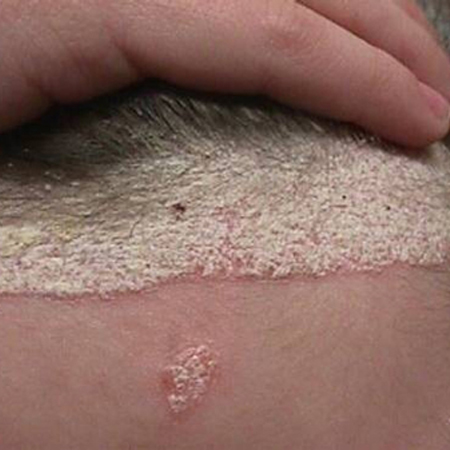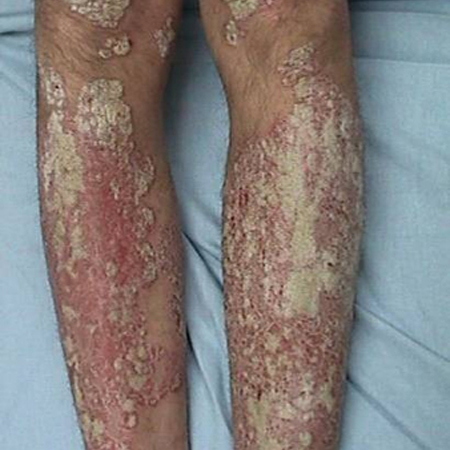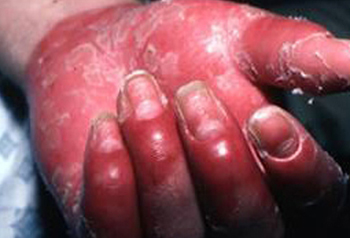History and exam
Key diagnostic factors
common
personal or family history of psoriasis
Very few patients diagnosed with psoriatic arthritis do not have psoriasis.
There is not a close correlation between the extent of skin disease and joint involvement except for the association of distal interphalangeal (DIP) joint arthritis and nail disease. Therefore, careful inspection of the patient's skin, including scalp, nails, limbs, and trunk should be performed.[Figure caption and citation for the preceding image starts]: Psoriasis plaque: scalpFrom the collection of Dr Tsu-Yi Chuang; used with permission [Citation ends]. [Figure caption and citation for the preceding image starts]: Nail psoriasis: pitted nailsFrom the collection of Dr Tsu-Yi Chuang; used with permission [Citation ends].
[Figure caption and citation for the preceding image starts]: Nail psoriasis: pitted nailsFrom the collection of Dr Tsu-Yi Chuang; used with permission [Citation ends]. [Figure caption and citation for the preceding image starts]: Psoriasis plaque: legsFrom the collection of Dr Tsu-Yi Chuang; used with permission [Citation ends].
[Figure caption and citation for the preceding image starts]: Psoriasis plaque: legsFrom the collection of Dr Tsu-Yi Chuang; used with permission [Citation ends].
joint pain and stiffness
Inflammatory joint pain is characterised by prolonged morning stiffness (>30 minutes), improvement with use, and recurrence with prolonged rest.
peripheral arthritis
Usually indicated by swelling and tenderness of individual joints (synovitis) during inspection and palpation.
Psoriatic arthritis (PsA) frequently presents in a pattern of monoarticular or oligoarticular joint involvement. In patients with multiple joints involved, the pattern lacks the symmetry of rheumatoid arthritis.
Early PsA may involve just a few lower extremity joints, such as the knees.
dactylitis
Uniform swelling of an entire digit, most commonly the third or fourth toes.[9][49] Reported in 40% to 50% of patients.[9] It may be difficult to determine whether the joints themselves are swollen. The majority of the swelling is in the flexor tenosynovium and will lead to limited motion. [Figure caption and citation for the preceding image starts]: Psoriatic arthritisFrom the collection of Dr Tsu-Yi Chuang; used with permission [Citation ends].
history of scalp or nail problems
Patients may not know they have psoriasis. The disease may be misinterpreted as scalp dandruff, seborrhoea, or onychomycosis. Nail symptoms such as pitting or onycholysis are present in around 80% to 90% of patients with psoriatic arthritis.[50]
Other diagnostic factors
uncommon
enthesitis
Heel pain, elbow pain, or lateral hip pain indicates entheseal inflammation. Enthesitis is observed in 30% to 50% of patients.[9] Diagnosed by demonstrating tenderness on palpation of the symptomatic entheses. Commonly observed areas of inflammation include sites of tendon insertion of the Achilles tendon, plantar fascia, and epicondyles.
spinal stiffness
Psoriatic disease tends to most severely affect the cervical spine, but this is not commonly seen at first presentation. Lumbar spine stiffness should also be assessed by way of a modified Schober test.
reduction of cervical spine mobility
Occurs as the disease progresses. Unusual to see clinical involvement with loss of motion early in the disease.
uveitis
Occurs in 8% of patients with psoriatic arthritis.[9]
Risk factors
strong
psoriasis
Regarded as the most significant risk factor. According to a large meta-analysis of psoriasis patients, the prevalence of concurrent psoriatic arthritis is around 20%, rising to 25% in patients with moderate-to-severe disease.[6]
family history of psoriasis or psoriatic arthritis
People who have a first-degree relative with psoriatic arthritis (PsA) are 40 times more likely to develop the disease compared with individuals without family history.[10]
Twin and family studies, human leukocyte antigen (HLA), and genome-wide scans have implicated multiple genetic influences for the risk of both psoriasis and PsA.[23]
weak
history of joint or tendon trauma
A small number of psoriatic arthritis patients may recall trauma prior to the onset of their arthritis.[12][14][24] This has been attributed to the equivalent of the Koebner phenomenon that is observed in the skin.[12] It is hypothesised that entheseal microtrauma may lead to initiation of the psoriatic inflammatory cascade.[24]
infection
Infection has been implicated as a trigger of psoriatic arthritis (PsA).[12][15] It possibly triggers PsA by exposing antigens to the innate immune system and leading to expression of the psoriatic phenotype. In the HIV population, the risk of psoriatic disease appears much higher than in the general population. A study in Zambia demonstrated that 96% of newly diagnosed PsA patients were HIV positive, compared with 30% of the adult urban population.[13]
Streptococcal infection is a common trigger of psoriasis, especially guttate, in the paediatric and young adult populations.
Use of this content is subject to our disclaimer